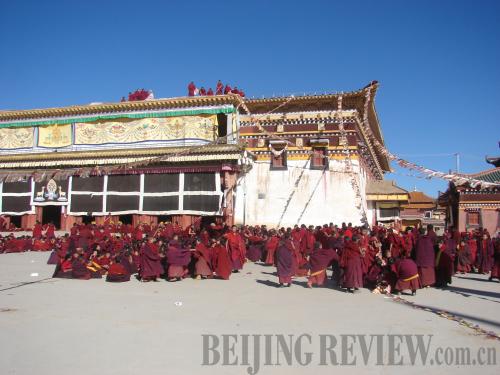|
 |
|
DEBATING SCRIPTURE: Monks gather for a debate on Buddhist scriptures at the square in front of a hall in the Kirti Monastery in Aba County, Sichuan Province, on December 7 (BAI SHI) |
Within the cloisters of the Kirti Monastery, the largest monastery of the Gelug sect of Tibetan Buddhism in Aba County, southwest China's Sichuan Province, monks in burgundy robes do their daily chores and devotees from nearby villages perform various rites in worship of the Buddha on a sunny winter morning in early December.
It seems that this temple is no different from any other in Sichuan's Tibetan-inhabited areas. But monks of the Kirti Monastery have been involved in over 22 incidents of self-immolation in Aba over the past three years.
Lacking evidence, police had been unable to prove any connection between the rash of self-immolations until a recent breakthrough pointed to a pattern of instigation by a monk and his nephew, announced the Sichuan police on December 9.
The 40-year-old Lorang Konchok is accused of having incited eight people to set themselves on fire since 2009. Three of the victims died. He also recruited Lorang Tsering, his 31-year-old nephew, to help instigate the immolations, according to a police statement.
Police started their investigation after a series of self-immolations took place in Aba in August. They detained Lorang Konchok on August 13 and Lorang Tsering on August 15.
Lorang Konchok, born in Aba and ordained at the Kirti Monastery in 1972, was an influential senior monk before his arrest. He confessed to inciting the self-immolation during detention.
After a Kirti monk named Tapey lit himself aflame in February 2009, police said that Lorang Konchok was contacted by Doan and Samten, two media liaisons of the Dalai Lama group's "Tibet independence" organization based in north India.
Doan was a Kirti monk in Aba. He snuck into India many years ago and is now the assistant of an exiled Kirti tulku who left for India with the Dalai Lama in 1959 and is a key member of the Dalai Lama group. He also has an affinity with Lorang Konchok.
Samten, 31, once studied Buddhist doctrine with Lorang Konchok in China. In 2000, Samten illegally fled across the border into India.
Lorang Konchok said that Doan and Samten told him to look for people willing to set themselves on fire and send back information so that they could pressure the Chinese Government by sending startling pictures to overseas media organizations.
Following secret overseas orders, Lorang Konchok took advantage of his position and influence in the monastery and encouraged young monks and followers to self-immolate, advocating that it did not violate Buddhist doctrines and those who did so were "heroes."
Lorang Konchok said that he also promised to spread information and pictures abroad so victims and their families would be acknowledged and honored.
Later, Lorang Konchok persuaded his nephew to help. Lorang Tsering was previously sentenced to three years' imprisonment for larceny.
Following the self-immolation incidents, Lorang Konchok and Lorang Tsering used a mobile phone to send pictures and other information of the victims to their overseas contacts belonging to the "Tibet independence" organization.
"They mailed me an iPhone from India," Lorang Konchok said during an investigation while in custody.
"I did not know my behavior had violated the law," Lorang Tsering confessed. "Now I regret it very much."
Brainwashed by Lorang Konchok, young monks and followers attempted self-immolation. Lorang Konchok pressed them, repeatedly asking the victims when and where they would perform self-immolation. As a result, three innocent people burned themselves to death.
| 